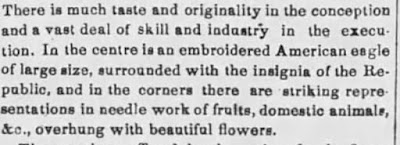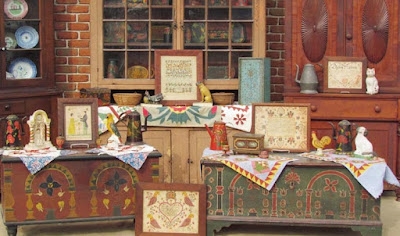Kent State University Collection
Yesterday we looked at this silk quilt with an eagle in the center, which fits a description of a famous Kentucky quilt shown at several state fairs and chosen to represent the U.S. at the 1851 world exhibition in London.
Description of quilt shown at the Fair.
Cooper-Hewitt Collection
Embroidered souvenir of the 1851 Crystal Palace exhibit
Elizabeth Hobbs Keckley or Keckly
(She spelled it Keckly.)

the eagle embroidered in the center over an American flag and the word "Liberty." I loved the story as I am quite a fan of Elizabeth Keckley and her tale as an independent and successful woman.
We shall discuss the book in part 5 this week.
The 1950 census found Ross and his mother living together in Medina County, Ohio. Ross is listed as an antique dealer. We find many references to his expertise and his business in Ohio newspapers over the years.
1978 Lecture on quilts
Ross also handled estate sales. Of particular interest is one he arranged for the Bissell-Ebright-Dague family of Medina in January, 1967.
I myself worked with that family in the early 1990s when we issued a new edition of Ruth Finley's book Old Patchwork Quilts and the Women Who Made Them.
Mary's self-pitying letters were published in the appendix to her book. (See Part 5 here for Elizabeth's denial she had anything to do with publishing those letters.) A list of items sold and not sold at "The Old Clothes Sale" is also in there. No quilt or bedding mentioned.
Read much more about the ill-fated wardrobe sale:
http://americanpast.blogspot.com/2013/04/mary-lincoln-in-new-york_23.html
From a 1967 feature story on the Bissell/Ebright/Dague sale in the Medina Gazette.
Ohioan Julia Bissell (1850-1933) married Leonidas Strickland Ebright and had two daughters, both writers. Ruth Ebright Finley had no children so her sister Mary Ebright Dague's heirs held the copyright to the book. The Dagues still had a few quilts from Ruth's collection, which we photographed. Not this one, however.
Ruth Ebright Finley (1884-1955)
Ruth was born in Ohio, became a journalist in Akron & Cleveland
and moved to Long Island, New York later in life.
She spent time in Ohio with her sister and friend Ross Trump.
For her 1995 Uncoverings paper "Ruth Finley and the Colonial Revival Era."
Ricky Clark interviewed Ross Trump and his partner Edson J. Brown in 1994.
Ricky's caption for the Lincoln Quilt
What we have here is a Lincoln/Keckley association as told by Ruth Finley to her friend Ross Trump.
Ross Trump's estate sale in 2020. He & Edson had quite a collection.
Ross told Ricky Clark that Ruth and sister Mary went antiquing with him and other collectors in Ohio. We do not know where she found the silk eagle quilt.
For corroboration of the connection, we can first look at Elizabeth Keckley's account of her life---In that book she mentions the word quilt only once and that is in reference to a quilted detail in clothing. Nowhere does she discuss patchwork or silk scraps.
Embroidery was labor intensive. How many stitchers
worked on borders for White House clothing?
Embroidered strip from the quilt
Mary Todd Lincoln in an embroidered dress 1861
Elizabeth was the head of an important dressmaking firm. She seems to have designed and fitted the clothing for Washington celebrities. She must have had quite a workroom of seamstresses keeping up with Mary Lincoln and her fashion rivals.
Mary gets an idea.
Actual needle use is rarely mentioned during the highpoint of Elizabeth's career in the war but here Lizzie is sitting with her friend and client and Lizzie is sewing. She noted she did not see the First Lady sewing during her White House years.
Mary and Elizabeth had a terrible falling out after the Civil War. Both in financial distress they cooperated in a venture to sell the clothes the Keckley workshop and others had made for the widow but the sale was viewed as terribly déclassé by the press.
What little money raised was also a source of contention between them but Elizabeth's autobiography telling frankly of White House years enraged Mary (as well it might.)
Elizabeth Hobbs Keckley (1818-1907) & Mary Todd Lincoln (1818-1882)
Tomorrow: Why is the eagle quilt associated with the two women above?
Read much more about the ill-fated wardrobe sale:
http://americanpast.blogspot.com/2013/04/mary-lincoln-in-new-york_23.html
Read Elizabeth Keckley's book, Behind the scenes; or, Thirty years a slave, and four years in the White house by clicking here:
http://books.google.com/books?id=0UsIAAAAQAAJ&printsec=frontcover&dq=elizabeth+keckley&hl=en&sa=X&ei=IusvT9PrK6GW2AX2t8WGDw&ved=0CDYQ6AEwAA#v=onepage&q=elizabeth%20keckley&f=false
http://books.google.com/books?id=0UsIAAAAQAAJ&printsec=frontcover&dq=elizabeth+keckley&hl=en&sa=X&ei=IusvT9PrK6GW2AX2t8WGDw&ved=0CDYQ6AEwAA#v=onepage&q=elizabeth%20keckley&f=false
But do remember she denied she wrote it.























No comments:
Post a Comment